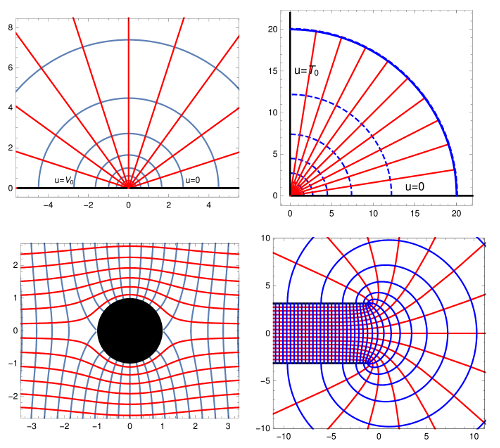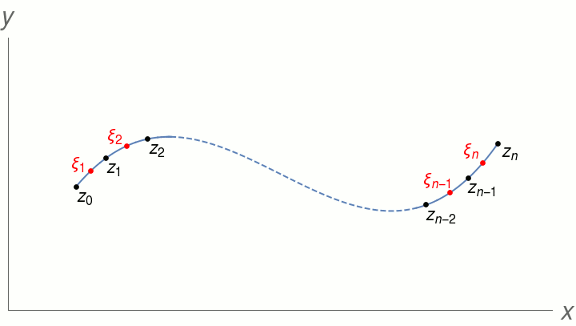PHYS20672 Summary 2
Conformal mappings
- If $u(x,y)+\ii v(x,y)$ is an analytic function of $z=x+\ii y$,
contours of constant $u$ and $v$ intersect each other at right
angles in the $z$-plane at every point where $f'(z)\ne0$.
- If $f$ is analytic, the mapping $w=f(z)$ preserves angles
and, for sufficiently small regions, shapes, wherever
$f'(z)\ne0$. The mapping is called conformal.
- Suppose we wish to find $u(x,y)$, the solution to Laplace's
equation $\del^2u=0$ subject to certain boundary conditions,
and that the mapping $Z=X+\ii Y=f(z)$ maps the boundaries to a
new, simpler geometry in which Laplace's equation can be
solved to give the potential function $\Phi(X,Y)$. Then
$u(x,y)=\Phi(X(x,y),Y(x,y))$ will be the solution to the
original problem.
- If $\Psi(X,Y)$ is conjugate to $\Phi(X,Y)$ (i.e., if
$\Phi+\ii\Psi$ is an analytic function of $Z=X+\ii Y$), lines
of constant $v(x,y)=\Psi(X(x,y),Y(x,y))$ represent field
lines, lines of heat flow or streamlines according to the
physical interpretation of the function $u(x,y)$. The analytic
function $u+\ii v$ is called the "complex potential".

In the diagrams above, the coloured lines are equipotentials
and flow/field lines for a variety of problems.
Spiegel 8.1-8.3, 9.1-3, 9.6, 9.7-12, 9.15-18, 9.22-23
Riley 18.7-9; Boas 14.9, 14.10; (Arfken 6.7)
Integration in the complex plane
- The path (or contour) integral of a complex function is
defined as $$\int_C f(z)\,\d z=\lim_{n\to\infty}\sum_{k=1}^{n}
f(\xi_k)(z_k-z_{k-1}),$$ where $z_0$ and $z_n$ are the
end-points of the contour, the other $z_k$ are points
distributed in order along the contour, and the points $\xi_k$
are chosen to lie between $z_{k-1}$ and $z_k$ on the contour.
Provided $f(z)$ is continuous and the limit is taken so that
all $(z_k-z_{k-1})\to 0$, the limit is unique for a given
path.

- For real functions of $x$ only, this corresponds to the
usual (Riemann) integral, i.e. the area under the curve
$f(x)$.
- We have
$$\int_C f(z)\,\d z=\int u\,\d x-\int v\,\d y+\ii\int v\,\d x+\ii\int
u\,\d y=\int(u,-v)\cdot\d\mathbf{r}+\ii\int(v,u)\cdot\d\mathbf{r},$$
where $\d\mathbf{r}\equiv(\d x,\d y)$. The last two integrals
are real line integrals in the $xy$-plane.
- Reversing the direction of the contour changes the sign of the integral.
- For compound curves,
$$\int_{C_1+C_2} f(z)\,\d z=\int_{C_1} f(z)\,\d z+\int_{C_2} f(z)\,\d
z\qquad\text{and}\qquad\int_{C_1-C_2} f(z)\,\d z=\int_{C_1} f(z)\,\d
z-\int_{C_2} f(z)\,\d z.$$
- The estimation lemma states $|\int_C f(z)\,\d z|\le ML$
where $L$ is the length of the curve and $M$ is the maximum
value of $|f(z)|$ along the curve.
- A Jordan curve is a closed, non-self-intersecting curve.
The integral along such a curve is denoted by $\oint$, and is
taken in an anticlockwise direction by default.
Spiegel 4.1-4.4, 4.7-8
Riley 18.10; (Boas 14.3); Arfken 6.3


